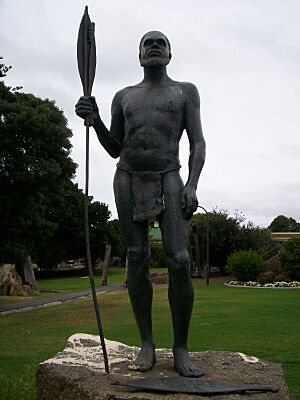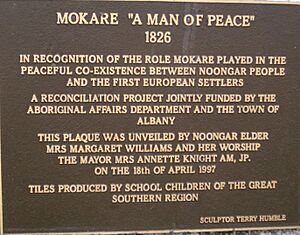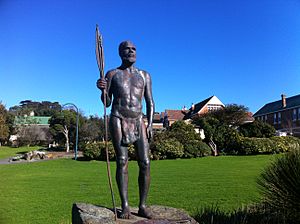Mokare facts for kids

Mokare (born around 1800 – died June 26, 1831) was an Aboriginal man. He belonged to the Noongar people from the southwest part of Australia. Mokare was very important in helping European explorers learn about the area.
Contents
Mokare's Life and Role
Mokare was part of the Minang clan of the Noongar people. He had at least two brothers, Mollian and Nakina. Nakina, like Mokare, often visited the new settlement at King George Sound. This place is now known as Albany. Mokare also had a sister who was married.
Meeting Explorers
Mokare likely met Phillip Parker King in 1821. King's ship stopped at King George Sound. King called him "Jack." Mokare was a friendly person who helped the ship's crew talk with the Noongar people.
In 1826, Mokare met the crew of a French ship called Astrolabe. They were sailing around the world.
Helping New Settlers
In 1827, Major Edmund Lockyer arrived at King George Sound. He came to start a new settlement there. Mokare showed Lockyer and other Europeans the local walking trails. These trails had been used by Noongar people for many years. Many of these old trails became important roads that are still used today.
Mokare became good friends with Isaac Scott Nind, a doctor's assistant. Mokare often visited Nind.
Guiding Expeditions
In December 1829, Mokare guided Thomas Braidwood Wilson on an expedition. During this trip, places like Mount Barker and Mount Lindsay were named. Rivers like Hay River and Denmark River were also named. Two months later, he guided Captain Collet Barker on a similar journey.
In 1831, Albany officially became part of the Swan River Colony. A Scotsman named Alexander Collie became the first government leader there. Mokare built a good relationship with Collie, just as he had with earlier leaders. He sometimes even lived in Collie's house.
Keeping the Peace
During Mokare's life, there was little fighting between the small European population and the local Minang people. This was because they did not compete for land or hunting areas. Mokare was known for being a skilled peacemaker. He helped solve problems between Aboriginal and white communities.
Mokare was worried when Governor James Stirling started to take control of the King George Sound settlement in 1830. He had heard about battles and conflicts between European settlers and Aboriginal people in other places. Mokare wanted King George Sound to remain a separate and peaceful settlement.
Mokare's Death and Legacy
Mokare became sick and died at Collie's house on June 26, 1831. Collie wrote about Mokare's burial. Both Noongar people and Europeans gathered at the house. They walked to a spot chosen by Mokare's brother, Nakina. The Europeans dug a grave. Mokare was buried with a buka cloak and other personal items, just as Nakina wanted.
When Alexander Collie was dying in 1835, he asked to be buried next to Mokare. Their graves were together under what is now the Albany Town Hall. Four years after Mokare died, a surveyor named John Septimus Roe had the graves dug up. Collie was reburied in the new Albany Cemetery. However, it is not known what happened to Mokare's remains.
A park with native bushland in Albany was named after Mokare in 1978. It is on the northern side of Mount Melville. In 1997, a statue of Mokare was put up in Alison Hartman Gardens on York Street in Albany. This was part of a project to bring people together.
Other Names for Mokare
Mokare's name was also written in different ways. Some of these spellings include Mokaré, Mokkare, Mawcarrie, Markew, or Makkare.
Dumont d'Urville wrote his name as "Maukorraï" in his book Voyage pittoresque autour du Monde.
Mokare's Portrait
A drawing of Mokare was made by Louis-Auguste de Sainson in 1826. This colored portrait appears in a book by Dumont d’Urville, Voyage et découvertes de l’Astrolabe..., Atlas, 1833. His name is written in the bottom right corner of the picture.



